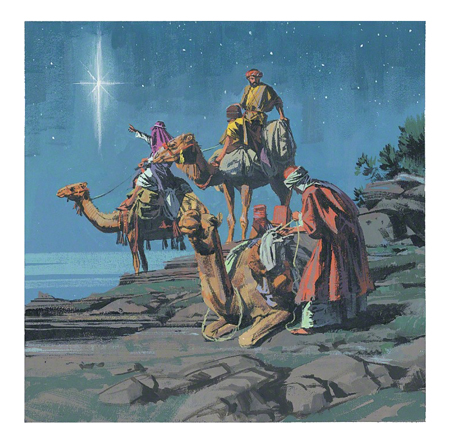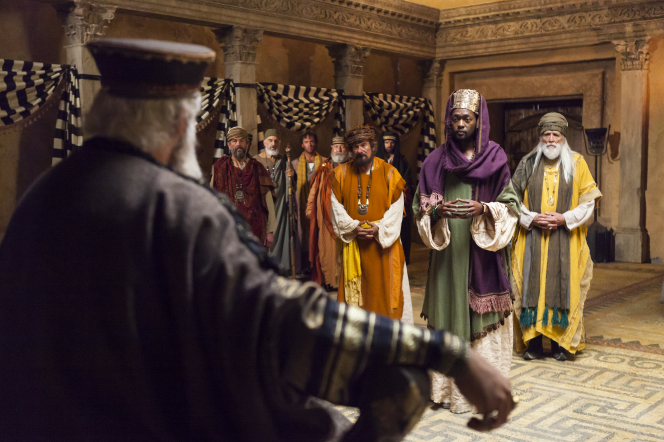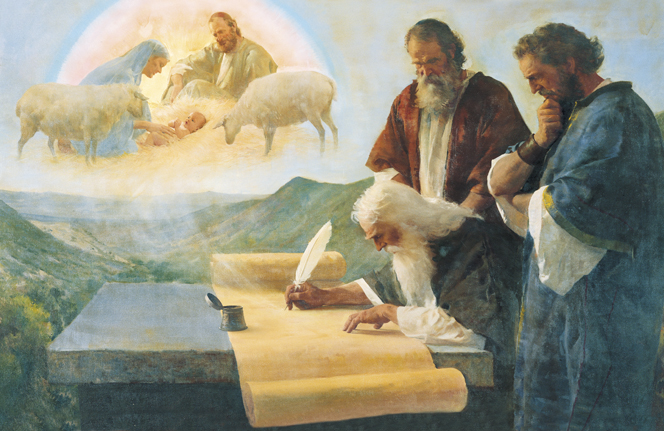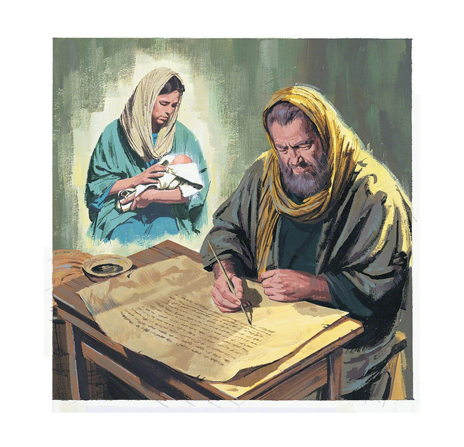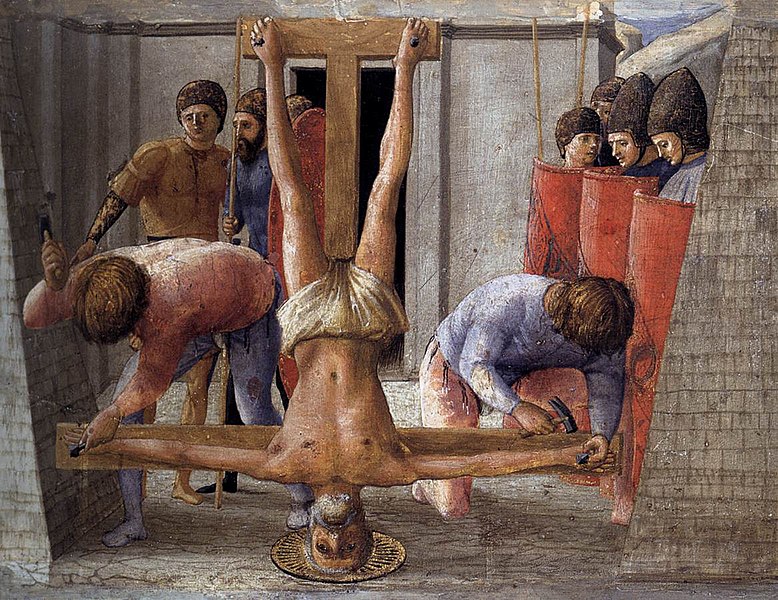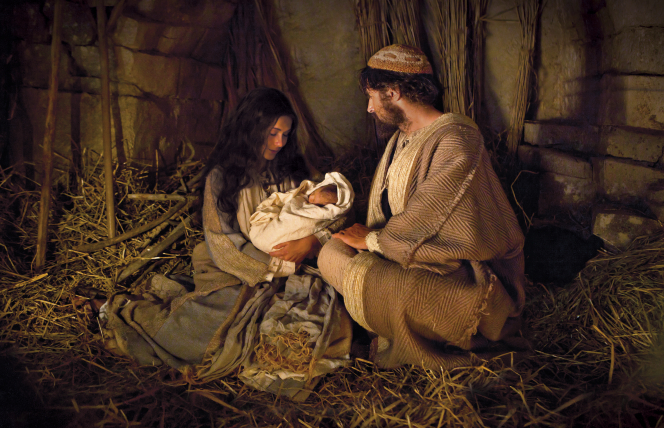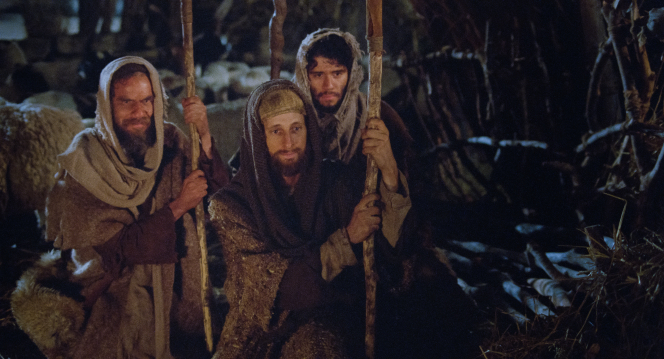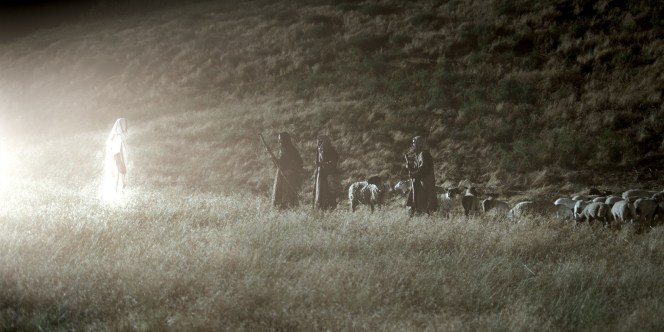Each Christmas, millions of people around the world read the Bible story of Christ's birth from the Gospels of St. Matthew and St. Luke. The Gospel of Matthew teaches:
"Now when Jesus was born in Bethlehem of Judæa in the days of Herod the king, behold, there came wise men from the east to Jerusalem, Saying, Where is he that is born King of the Jews? for we have seen his star in the east, and are come to worship him (KJV Holy Bible, Matthew 2:1-2)."
Who were these "wise men from the east"? How did the wise men know that the appearance of a new star signified the birth of the Jewish Messiah? What can astronomy and mathematics teach us about the new star that appeared? These are questions that will be discussed in this blog post.
Although we do not possess the New Testament in its original form, the earliest New Testament manuscripts we have are written in Koine Greek (See Note 1 to learn more). Where the King James Version of the Bible says "wise men", these Greek transcripts say "magi". The magi were royal priests and scholars in Persia, Babylon, India, and Arabia. The magi were literate and studied religious texts. They also had great knowledge of astronomy.
In the Old Testament, we read about Jerusalem being conquered by Babylon shortly after 600 B.C. (The Book of Mormon teaches that 600 BC is when Lehi and his family left Jerusalem after Lehi had received a vision that Jerusalem would be destroyed due to its wickedness.) The Jews were taken captive into Babylon. Daniel, a righteous Jew, became a personal adviser to the Babylonian King Nebuchadnezzar. When the Persians conquered the Babylonians, they freed the Jews and gave them the option to return to Jerusalem and rebuild their temple. A righteous Jew named Esther became a Persian queen. Due to this history, both the Babylonian and Persian magi were well acquainted with Jewish sacred literature. Although most of the magi were Zoroastrians, some of the magi likely were Jewish.
When the wise men arrived in Jerusalem and told Herod that they had seen the Messiah's star and were come to worship Him, Herod "was troubled, and all Jerusalem with him (KJV Holy Bible,
Matthew 2:3)." The fact that all of Jerusalem was troubled suggests that the Jews did not recognize the new star as a sign of their Messiah's birth. This can be partially explained by the wicked condition of most of the Jews at the time. However, there were some Jews who were still righteous. Why didn't the righteous Jews recognize the new star as a sign of their Messiah's birth? The only Old Testament prophecy regarding a new star appearing at the time of the Messiah's birth is the following:
"I shall see him, but not now: I shall behold him, but not nigh: there shall come a Star out of Jacob, and a Sceptre shall rise out of Israel, and shall smite the corners of Moab, and destroy all the children of Sheth (KJV Holy Bible, Numbers 24:17)."
As can be seen, the prophecy regarding the new star was rather vague. Let us assume for a minute that this scripture alone could allow people to recognize the new star as a sign of Christ's birth. Most estimates of the population of Jerusalem at the time of Christ range from 15,000 to 100,000 people. Even if the population was only 15,000 and only 1 percent of the people in Jerusalem were looking for the signs of Christ's birth, 150 people should have recognized the new star as such a sign. Yet, no one did. Math makes it apparent that the Jewish scriptures alone were not enough to recognize the star as a sign of Christ's birth.
How, then, did the wise men know that the Savior had been born? LDS Apostle Bruce R. McConkie said of the wise men, "Rather, it would appear they were true prophets, righteous persons like Simeon,
Anna, and the shepherds, to whom Deity revealed that the promised
Messiah had been born among men (
Doctrinal New Testament Commentary)." This view is consistent with mathematics.
Matthew's account of the wise men continues:
"And when [Herod] had gathered all the chief priests and scribes of the people together, he demanded of them where Christ should be born. And they said unto him, In Bethlehem of Judæa: for thus it is written by the prophet, And thou Bethlehem, in the land of Juda, art not the least among the princes of Juda: for out of thee shall come a Governor, that shall rule my people Israel. Then Herod, when he had privily called the wise men, inquired of them diligently what time the star appeared. And he sent them to Bethlehem, and said, Go and search diligently for the young child; and when ye have found him, bring me word again, that I may come and worship him also. When they had heard the king, they departed; and, lo, the star, which they saw in the east, went before them, till it came and stood over where the young child was. When they saw the star, they rejoiced with exceeding great joy. And when they were come into the house, they saw the young child with Mary his mother, and fell down, and worshipped him: and when they had opened their treasures, they presented unto him gifts; gold, and frankincense, and myrrh (KJV Holy Bible, Matthew 2:4-11)."
What was this new star that appeared to signify Christ's birth and guided the wise men to the home of Mary and Joseph? A variety of early Christian writings by such prominent church leaders and scholars as Ignatius, St. James, and Eusebius teach us that the new star was different from the other stars in the sky; the new star was indescribably bright, thereby preventing the other stars in the sky from being seen. Korean and Chinese astronomers from the time of Christ's birth also recorded an incredibly bright star appearing. We read in the Book of Mormon that, when the new star appeared, "there was no darkness in all that night, but it was as light as though it was mid-day (Book of Mormon,
3 Nephi 1:19)."
There is only one known astronomical object that can accomplish such a feat; the most likely explanation is that the new star was a supernova. A supernova occurs when a star explodes suddenly. At its peak, a supernova can release more light than the rest of the stars in the galaxy combined. Thus, a supernova can make it light outside during the night time. Supernovas are rare. There have only been five clearly documented supernovas that have been visible without the aid of large telescopes. These occurred in 1006, 1054, 1181, 1572, and 1604 A.D. The ones in 1006 A.D. and 1054 A.D. were so bright that they cast shadows and could be seen during the day time. Each of these five supernovas faded away within six months to three years. By some simple math, it can be estimated that there have probably been fewer than ten supernovas such as the one seen when Christ was born that have occurred since the time of Adam and Eve (See note 2). Although Christ was born in a humble stable, his birth was displayed in the heavens with incredible grandeur.
One lesson that math and astronomy allow us learn from the new star's appearance is the level of planning that God has put into His Plan of Salvation. As Elder Neal A Maxwell once said, "Recall the new star that announced the birth at Bethlehem? It was in its precise orbit long before it so shone (
Encircled in the Arms of His Love)." Earth and the supernova had an enormous gap of space and time. Yet, God's plan was so well-orchestrated that the star appeared on the exact night that the Son of God entered this world. Using math and astronomy, we can estimate how long before Christ's birth the Star of Bethlehem was placed in orbit. We get an estimate of about one million years or longer (See note 3 to see how I calculated this).
Mathematics can also help us better understand the role the Star of Bethlehem played in guiding the wise men to the Christ child. Some people have incorrectly assumed that the star guided the wise men to the specific house Joseph, Mary, and Jesus lived in. This is a reasonable assumption when only
verses 9 through 11 of Matthew 2 are considered. However, math shows this to be a completely unreasonable assumption. The nearest star to earth, named Proxima Centauri, is approximately 4.25 light years (25 trillion miles) away. Even if the star the wise men followed was as close as Proxima Centauri and Mary and Joseph lived a full mile away from their nearest neighbor, trigonometry tells us that the angle of the star in the sky would only be 1/4,300,000,000 degrees different for someone standing at Mary and Joseph's house and someone standing at their nearest neighbor's house. Since the human eye can only see angular differences of 0.02 degrees and bigger, the wise men could not have seen a change in the star's position as they walked around the streets of Bethlehem. The far more likely scenario is that the wise men started asking citizens of the small town of Bethlehem where the Messiah was. Since the shepherds had already told the people of Bethlehem about Jesus' birth (See
Luke 2:15-18), someone was likely able to lead the wise men to the house of Mary and Joseph.
A final thing math can teach us about the wise men is how long it took them to get to Jerusalem. Babylon has a straight-line distance from Jerusalem of 520 miles. However, the path most people took from Babylon to Jerusalem was about 900 miles. Persia was over 1000 miles away. Although it may be a shock to some people, cars weren't available back then. When groups made long journeys by foot, donkey, or camel, about 20 miles were covered per day. Thus, it probably took the wise men about two months to get to Jerusalem. Bethlehem is only about 5 miles away from Jerusalem, so the wise men could have made it to Bethlehem in a couple hours. Some people have assumed that it took the wise men about two years to get to Jerusalem. This assumption is derived from the fact that Herod killed all of the children that had been born within the past two years. There are two possible explanations for the two year time frame. The first possibility is that it could have taken the wise men a while to get their group ready to travel to Jerusalem with their gifts. The second possibility is that Herod was trying to be extremely sure that the Messiah was killed.
Note 1: Koine Greek is the Grecian dialect that was spoken throughout the Mediterranean and Middle Eastern regions following the conquest of much of the Old World by Alexander the Great over 300 years before Christ's birth.
Note 2: According to the Biblical chronology, it has been approximately 6000 years since Adam and Eve were exiled from the Garden of Eden. Adam died at the age of 930 (Holy Bible,
Genesis 5:5). Thus, it has been about 5000 years since the time of Adam and Eve. Since the only three known occurrences of supernovas that made it light at night occurred about 1000 (two of them) and about 2000 years ago, it can be estimated that such a supernova occurs less frequently than once every 500 years. 5000 divided by 500 yields an estimate of fewer than ten such supernova.
Note 3: Using the stellar mass-luminosity formula, it can be found that a star about 40 times the mass of the sun will have a lifetime of around one million years. 40 times the mass of the sun is about the upper limit for the mass of a star that will explode as a supernova. Smaller stars will live longer before exploding. Thus, the Star of Bethlehem was probably in its orbit for about one million years or longer. Taking into account the time the light took to travel from the supernova to the earth does not change this estimate. Most of the stars we can see with our naked eye are within a few hundred light years of the earth. Even though a supernova at its peak can give off as much light as a few hundred billion stars, the fact that the Star of Bethlehem made it light outside at night suggests that it was within ten thousand light years of the earth. Ten thousand additional years is insignificant compared to a rough estimate of at least one million years.






